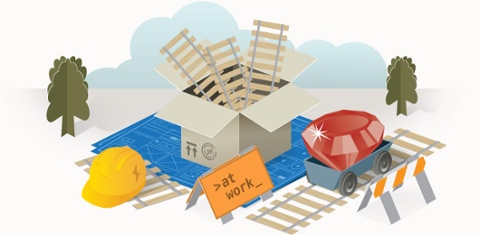
Ruby on Rails is an open source web application framework built on Ruby. While Rails is 100% free, there is a lot of argument over its effectiveness in comparison with more standard, tried-and-true web applications. Despite its criticism, many big players such as Hulu, Groupon, and Twitter have incorporated its use into their booming platforms, so it is definitely worth at least knowing a little bit more about it.
Like most open-source frameworks, Rails has found a home in the agile community. This modern approach to software development promotes early deliveries, feedback from the client, and adaptation over the course of the development process. Because of its malleable nature, Ruby on Rails development works well with this approach.
Like most open-source frameworks, Rails has found a home in the agile community. This modern approach to software development promotes early deliveries, feedback from the client, and adaptation over the course of the development process. Because of its malleable nature, Ruby on Rails development works well with this approach.
1. Don’t Repeat Yourself
Is this code DRY enough? If a code only exists in one place, changing it later will be much easier. Rails is equipped with helpers and libraries to help implement this approach. More concise and efficient code allows changes to be made easily later on in the development cycle, as is the norm in an Agile methodology.
2. Test-drive Your Code
Not only do tests ensure that features work, but they later come in handy when changes are being made to assure everything runs correctly. Starting tests are automatically generated for you in Ruby, which help to ensure that tests are run at every process in development (which, again, is important in Agile development).
3. Focus on Convention over Configuration
Ruby on Rails comes with conventions to spend less time configuring, such as generators that enable you to setup fast, and a multi-environment setup that is part of the package. Also included are pre-configurations for HTTP servers, meaning changes can be made to the live-site to satisfy the client demands face-to-face. With common web programming tasks out of the way (and more concise and readable), more time can be devoted to catering towards the clients specifications. A project that is easy and fast to modify will work best in an Agile environment.
4. Be Dynamic
Rails is constantly changing and adapting to the tech industry. When other frameworks develop new techniques, Rails is quick to follow through with their ideas. Rails has a thriving online community, consisting of blogs, conferences, IRC channels, and gems, which is the term used for Ruby software packages. All these make it easier to revise and update features for the product so that it is ready for the current environment.
Agile has a strong focus on constant adaption in coordination with the client. Quickness, efficiency, and quality are key factors in implementing development in this method. Ruby on Rails is designed to be fast, simple, and malleable, and because of this has grown to be extremely popular.